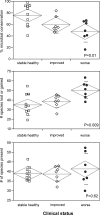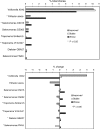Changes in periodontal health status are associated with bacterial community shifts as assessed by quantitative 16S cloning and sequencing
- PMID: 17021095
- PMCID: PMC1594761
- DOI: 10.1128/JCM.00317-06
Changes in periodontal health status are associated with bacterial community shifts as assessed by quantitative 16S cloning and sequencing
Abstract
The gingival sulcus contains a complex ecosystem that includes many uncultivated bacteria. Understanding the dynamics of this ecosystem in transitions between health and disease is important in advancing our understanding of the bacterial etiology of periodontitis. The objective of this longitudinal study was to examine the stability of bacterial colonization in the gingival crevice and to explore the relationship between shifts in microbial composition and changes in periodontal health status using a comprehensive, quantitative, culture-independent approach. Subgingival plaque samples and periodontal data were collected from 24 subjects over 2 years. Baseline and 2-year plaque samples were analyzed using quantitative ribosomal 16S cloning and sequencing. Ten subjects remained periodontally healthy over 2 years, the periodontal health of seven subjects worsened, and seven subjects showed clinical improvement. Bacterial stability was greatest among healthy, clinically stable subjects and lowest for subjects whose periodontal status worsened (P = 0.01). Higher numbers of species lost or gained were also observed for subjects whose clinical status changed (P = 0.009). This provides evidence that a change in periodontal status is accompanied by shifts within the bacterial community. Based on these data, measures of microbial stability may be useful in clinical diagnosis and prognosis. Regarding individual species, increases in levels of the uncultivated phylotype Veillonella sp. oral clone X042, a gram-negative bacterium and the most common member of the subgingival bacterial community, were associated with periodontal health (P = 0.04), suggesting that this is an important beneficial species. Filifactor alocis, a gram-positive anaerobe, was found at higher levels in subjects with disease (P = 0.01).
Figures



References
-
- Cebra, J. J. 1999. Influences of microbiota on intestinal immune system development. Am. J. Clin. Nutr. 69:1046S-1051S. - PubMed
-
- Cullinan, M. P., S. M. Hamlet, B. Westerman, J. E. Palmer, M. J. Faddy, and G. J. Seymour. 2003. Acquisition and loss of Porphyromonas gingivalis, Actinobacillus actinomycetemcomitans and Prevotella intermedia over a 5-year period: effect of a triclosan/copolymer dentifrice. J. Clin. Periodontol. 30:532-541. - PubMed
-
- Dahlen, G., and A. Leonhardt. 2006. A new checkerboard panel for testing bacterial markers in periodontal disease. Oral Microbiol. Immunol. 21:6-11. - PubMed
-
- Hutter, G., U. Schlagenhauf, G. Valenza, M. Horn, S. Burgemeister, H. Claus, and U. Vogel. 2003. Molecular analysis of bacteria in periodontitis: evaluation of clone libraries, novel phylotypes and putative pathogens. Microbiology 149:67-75. - PubMed
Publication types
MeSH terms
Substances
Grants and funding
LinkOut - more resources
Full Text Sources
Other Literature Sources

